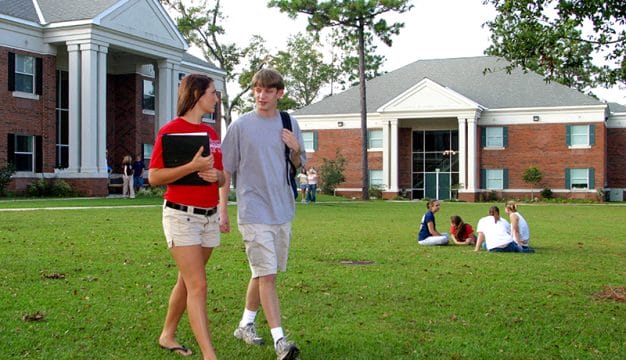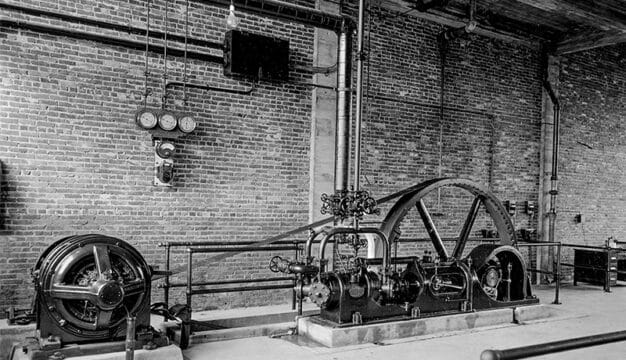Birmingham-Southern College
 Birmingham-Southern College
Birmingham-Southern College (BSC) is Alabama’s only nationally ranked liberal arts college. For more than a century and a half, it has remained committed to a particular ideal: academic excellence directed at a career in service of others. Its graduates can be found in all walks of life, but particularly in medicine, law, the ministry, and teaching.
Birmingham-Southern College
Birmingham-Southern College (BSC) is Alabama’s only nationally ranked liberal arts college. For more than a century and a half, it has remained committed to a particular ideal: academic excellence directed at a career in service of others. Its graduates can be found in all walks of life, but particularly in medicine, law, the ministry, and teaching.
The college dates back to 1856, when Alabama Methodist reformers founded Southern University in Greensboro, Hale County. The college was founded by the Alabama Conference of Methodists with $113,000 donated by prominent Greensboro citizens to prepare students through rigorous academic study to succeed in an aggressive world of progress and commerce. They believed that a failed student was at the world’s mercy, unable to govern even himself. A successful student, by contrast, was free of that world and was then able to serve others. “Academic excellence for selfless service” would remain the institution’s standard.
In 1861, three weeks after its second class graduated, Union and Confederate armies met at Manassas, Virginia, in the first major battle of the Civil War. Virtually all of Southern’s students enlisted and headed to the front. The university did manage to keep its doors open during the conflict, but four years later the South had lost the war and Southern University had lost its endowment. The university, in small and isolated Greensboro, began decades of slow decline.
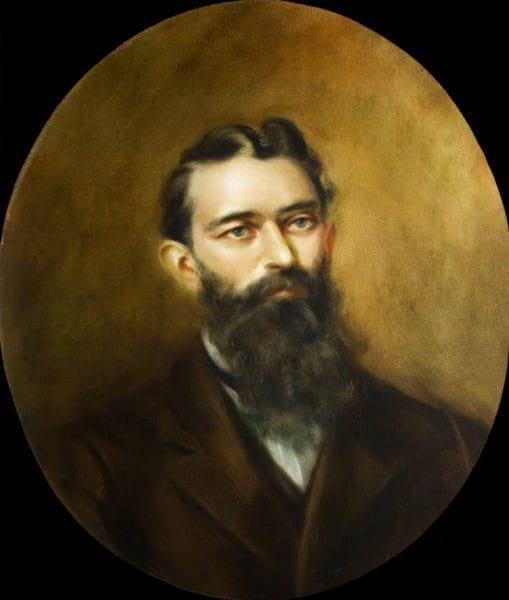 Thomas Seay
During the lean years, Southern University maintained its vision of sending graduates out to serve the greater whole. To give formal structure to that vision, the university established separate schools of law, medicine, and liberal arts, which included theology. Its graduates in the post-war era included such statesmen as Thomas Seay, who served as governor from 1886 to 1890. Other graduates later became doctors, but only about a half-dozen graduated from its short-lived medical college. The university was much more successful with its liberal arts graduates, many of whom became teachers and professors. During its six decades in Greensboro, four Methodist bishops and countless ministers graduated from Southern University. Women were first allowed to attend classes as early as 1867, but it was not until 1897 that the first woman graduated. Already challenged by its isolation, declining enrollment, and poor endowment, another hurdle emerged in the late 1890s when north Alabama Methodists established a rival institution, Birmingham College. Southern University was located in a declining cotton town, whereas Birmingham College was on a hilltop just west of the state’s most dynamic city, amid iron and steel foundries, railroads, and other growing corporations and businesses. The Methodist Church could not adequately support a college in Greensboro and a college in Birmingham, so the Methodist trustees merged the two schools in 1918 to form Birmingham-Southern College (BSC) on the grounds of Birmingham College.
Thomas Seay
During the lean years, Southern University maintained its vision of sending graduates out to serve the greater whole. To give formal structure to that vision, the university established separate schools of law, medicine, and liberal arts, which included theology. Its graduates in the post-war era included such statesmen as Thomas Seay, who served as governor from 1886 to 1890. Other graduates later became doctors, but only about a half-dozen graduated from its short-lived medical college. The university was much more successful with its liberal arts graduates, many of whom became teachers and professors. During its six decades in Greensboro, four Methodist bishops and countless ministers graduated from Southern University. Women were first allowed to attend classes as early as 1867, but it was not until 1897 that the first woman graduated. Already challenged by its isolation, declining enrollment, and poor endowment, another hurdle emerged in the late 1890s when north Alabama Methodists established a rival institution, Birmingham College. Southern University was located in a declining cotton town, whereas Birmingham College was on a hilltop just west of the state’s most dynamic city, amid iron and steel foundries, railroads, and other growing corporations and businesses. The Methodist Church could not adequately support a college in Greensboro and a college in Birmingham, so the Methodist trustees merged the two schools in 1918 to form Birmingham-Southern College (BSC) on the grounds of Birmingham College.
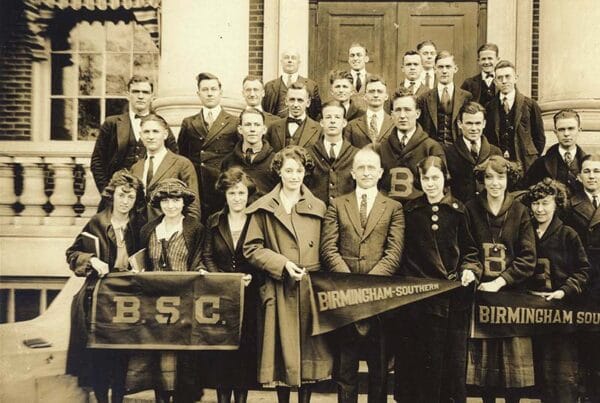 President Guy Snavely and Students
Academician Guy Snavely arrived soon after the merger to serve as president. Snavely was first and foremost a scholar. His doctorate in Romance Languages was earned at the Johns Hopkins University, then the country’s foremost graduate program. He had depth of experience in both teaching and publishing and was young and enthusiastic. He would devote the rest of his life to Birmingham-Southern. Barely a year after his inauguration, Snavely helped lay the cornerstone to a new library. A few years later, the college’s commanding main building, Munger Hall, was completed, and a new student union building replaced one destroyed in a fire.
President Guy Snavely and Students
Academician Guy Snavely arrived soon after the merger to serve as president. Snavely was first and foremost a scholar. His doctorate in Romance Languages was earned at the Johns Hopkins University, then the country’s foremost graduate program. He had depth of experience in both teaching and publishing and was young and enthusiastic. He would devote the rest of his life to Birmingham-Southern. Barely a year after his inauguration, Snavely helped lay the cornerstone to a new library. A few years later, the college’s commanding main building, Munger Hall, was completed, and a new student union building replaced one destroyed in a fire.
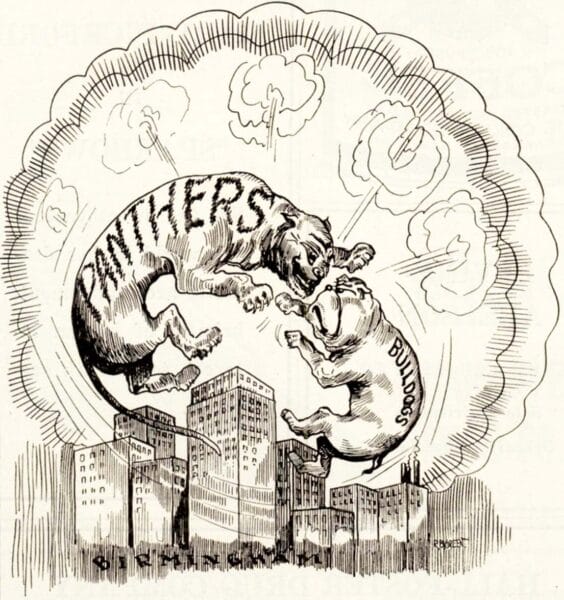 Magic City Classic Cartoon, 1926
Snavely’s overriding goal was not to build the college physically, but to strengthen its academic programs. He assembled a faculty that earned Birmingham-Southern a reputation for outstanding teaching and scholarship. The college thrived, and when Snavely prepared to step down in 1937, it boasted an impressive number of students. That same year, BSC was awarded Alabama’s second Phi Beta Kappa chapter (the nation’s oldest and most prestigious college honor society) in recognition of its high academic standards. (BSC’s chapter of Omicron Delta Kappa, honoring leadership, is the 10th oldest in the United States.) What had begun as a Methodist college in Greensboro with schools in theology, medicine, law, and the liberal arts grew into one of the South’s elite colleges, encompassing a wide range of academic majors. Graduates are consistently accepted into top medical schools and law schools. Not all of the students’ time was spent studying, however. Until 1939, autumns at BSC were consumed with football. The Panthers beat the Auburn University Tigers three times, and the BSC-Howard (now Samford University) rivalry was the biggest in Alabama. The 1990 and 1995 BSC basketball teams were the National Association of Intercollegiate Athletics (NAIA) champions; and the baseball team won the NAIA national championship in 2001.
Magic City Classic Cartoon, 1926
Snavely’s overriding goal was not to build the college physically, but to strengthen its academic programs. He assembled a faculty that earned Birmingham-Southern a reputation for outstanding teaching and scholarship. The college thrived, and when Snavely prepared to step down in 1937, it boasted an impressive number of students. That same year, BSC was awarded Alabama’s second Phi Beta Kappa chapter (the nation’s oldest and most prestigious college honor society) in recognition of its high academic standards. (BSC’s chapter of Omicron Delta Kappa, honoring leadership, is the 10th oldest in the United States.) What had begun as a Methodist college in Greensboro with schools in theology, medicine, law, and the liberal arts grew into one of the South’s elite colleges, encompassing a wide range of academic majors. Graduates are consistently accepted into top medical schools and law schools. Not all of the students’ time was spent studying, however. Until 1939, autumns at BSC were consumed with football. The Panthers beat the Auburn University Tigers three times, and the BSC-Howard (now Samford University) rivalry was the biggest in Alabama. The 1990 and 1995 BSC basketball teams were the National Association of Intercollegiate Athletics (NAIA) champions; and the baseball team won the NAIA national championship in 2001.
By the mid-1950s, BSC was known mainly as a genteel southern college, but the civil rights era, much of which was played out in nearby Birmingham, proved a difficult time for the college. Pres. Henry King Stanford resisted those trustees and politicians who opposed integration. Stanford protected from expulsion 97 BSC students who had signed a petition protesting Gov. John Patterson‘s expulsion of nine Alabama State University students for holding a sit-in. The president also protected Tom Reeves, a BSC ministerial student who had been arrested on charges of vagrancy after asking a group of white segregationist laymen to desegregate their organization. Stanford finally resigned in 1962 after racists labeled BSC “red-pink communist.” The next year, Birmingham police trained hoses and police dogs on demonstrators protesting segregation. In September 1963, two weeks after the bombing of the Sixteenth Street Baptist Church, a nervous BSC administration warned students to stay away from groups associated with “anarchy and violence.” Some did and some did not. In 1965, black students began taking courses at the college and the college was finally integrated.
On top of the civil rights disturbances came the Vietnam War. The country was in turmoil, and so was BSC, which began to have trouble recruiting new professors and raising money during these difficult social and economic times. Five presidents oversaw the campus in the span of 10 years as enrollments and financial resources dwindled.
When Neal Berte assumed the presidency in 1976, BSC was facing financial collapse. By using his personal appeal and financial acumen, Berte pulled the college back from economic catastrophe; during his 28 years as president, the campus was transformed with new buildings and upgraded facilities. In 1996, the school established its EcoScape Program, which incorporates art, education, and organic gardening techniques to teach sustainable community landscape management principles. It is a project of the Southern Environmental Center at Birmingham-Southern, which also manages the Turkey Creek Nature Preserve, home to the endangered vermilion darter (Etheostoma chermocki). David Pollick, who assumed the presidency in 2004, once again committed Birmingham-Southern to the ideals of its founders, calling on the graduating students to lead and serve society.
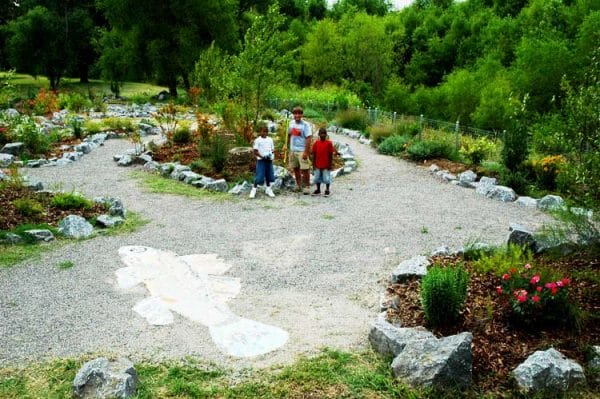 BSC EcoScape
The college’s sesquicentennial year, 2006, found more than 70 percent of its nearly 1,300 students volunteering to perform service work locally, across the country, and overseas. They came from more than 30 states and 16 foreign countries to take classes in more than 50 programs of study, in addition to interdisciplinary and individualized majors. The college currently has nearly 50 buildings clustered on 192 wooded acres in western Birmingham. On that campus Birmingham-Southern College is entering its next 150 years with its students, faculty, and staff committed to the purpose on which it was founded in 1856: academic excellence for selfless service.
BSC EcoScape
The college’s sesquicentennial year, 2006, found more than 70 percent of its nearly 1,300 students volunteering to perform service work locally, across the country, and overseas. They came from more than 30 states and 16 foreign countries to take classes in more than 50 programs of study, in addition to interdisciplinary and individualized majors. The college currently has nearly 50 buildings clustered on 192 wooded acres in western Birmingham. On that campus Birmingham-Southern College is entering its next 150 years with its students, faculty, and staff committed to the purpose on which it was founded in 1856: academic excellence for selfless service.
Further Reading
- Brown, Donald. Forward, Ever: Birmingham-Southern College at its Sesquicentennial. Birmingham: Birmingham-Southern College, 2005.
- Hubbs, G. Ward. Guarding Greensboro: A Confederate Company in the Making of a Southern Community. Athens: University of Georgia Press, 2003.
- Parks, Joseph H. and Oliver C. Weaver Jr. Birmingham-Southern College, 1856-1956. Birmingham: Birmingham-Southern College, 1957.
